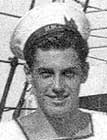
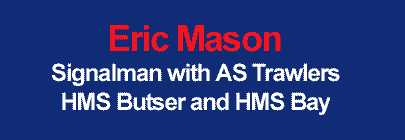
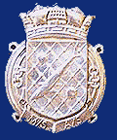
 |
 |
 |
|
Eric
Mason's story
(part 2) |
| As
the days passed by the sea became much bluer and calm and the weather
beautiful and warm. We were told to enjoy it as we were then some 500
miles from the South American coast and would be heading back towards
Gibraltar where it was much colder. We had in fact sailed a great half
cycle which had taken us out of the range of the large German 4-engined
Folke Wolfe bombers based in France |
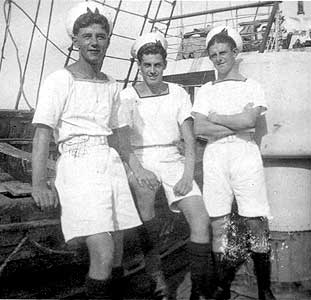 |
Everything
seemed to go like clockwork. We were transferred by harbour launch to
the 'Edinburgh Castle', the Army contingent ferried ashore to the Depot
of the British West African Frontier Force and the RAF lads by RAF launch
further up the river to Waterloo, the Flyboat Station. |
| (above)3 Signalmen together aboard Edinburgh Castle, December 1943 Left to right: Clifford 'Paddy' Hutton (from Armargh) Eric Mason (from Sheffield) David Garrett |
Our Base Ship which dealt with all the paper work, provisions, staffing etc was a large merchant ship, the 'Philoctetes II', named after a Greek God, and which was fully equipped as a Engineering Works Ship capable of carrying out all repairs - short of building a new ship. On
Christmas Eve the ships we were to join came in and moored alongside
the base ship. They were Asdic Trawlers (SONAR) about 170 feet long
and were the deep sea fishing sort of trawlers fitted with depth charge
rails at the stern and 2 depth charge throwers on the port and starboard
sides. Guns were fitted on platforms either side of the bridge and over
the after deck. A 12 powder gun was mounted on the forecastle head.
They were also equipped with Radar and Echo-sounding gear. A full crew
was 50 persons including the officers. |
The trawlers were of the Hill Class being named after hills in England , namely 'Butser', 'Birdlip', 'Duncton', 'Dunkery', 'Inkpen', 'Portsdown', 'Yestor' and 'Bredon'. They were built at Cook, Welton and Gemmell's Shipyard at Beverley in 1941. HMS Butser was the ship I joined and had in fact been launched on the 29th July 1941. She proved to be a lucky ship for me as the 29th July was my birthday. Of the eight ships in the class, the 'Bredon' had sunk in February 1943 when on escort in the South Atlantic, so only 7 remained. We were soon aboard
our respective ships, relieving the signalmen who were to return home
and after taking stores on board we moved out to the mooring bays to
load coal and water for the next trip. Water was the last to be taken,
and once we left harbour none could be used for washing purposes. It
was salt water showers or nothing until we returned.. |
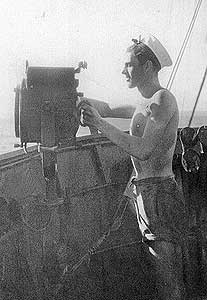 |
|
Our job was to escort slow cargo boats (about 9 knots) to the various harbours along the West African Coast, places like Dakar, Takoradi, Lagos, Monrovia, Pointe Noire. On occasions we would screen a cargo ship off a surf port. This was where there was no harbour. The ship would anchor a safe distance from the surf breaking on the beach and near to where a large jetty or pier reached out into deep water. A small tugboat would be then dropped into the water by a crane followed by barges. These were then towed out to the ship and cargo was loaded and unloaded this way. This was a very tedious job as we had to mount an anti-sub sweep by Asdic and it meant a week or more sailing up and down offshore manning a watch throughout the 24 hours. Usually we took small convoys of about 9 main ships which were dropped off at the ports where we picked up others which had already loaded. Quite a busy traffic, the loaded ships being taken south and handed over to an escort from Gibraltar for the eventual trip to England. Our escort was usually comprised of a large frigate, 2 sloops, 2 corvettes and 3 trawlers. The 3 faster ships were to the front of the convoy, the corvettes either side and the trawlers to the rear, all keeping an underwater Asdic sweep for any U-boats. There were also Sunderland Flying Boats from Freetown,
Hercules arising from Takoradi and Cameron Catalanians from Ascension
Island which over flew the area we were in, hunting for signs of U-boats.
The U-boats were not as active in our area in 1944 as previously as
most of them were in the South Atlantic plaguing one of the large convoys
from America and a great number were being sunk by the new hunter-killer
groups which had been formed to destroy them. The RAF were also having
their uses in France which cut their numbers down. We did however still
have a few long range boats which had been in the Indian Ocean and the
South Atlantic and which headed back for home, coming our way. The war
in the Far East was also going better in our favour, so the threat of
Japanese submarines coming our way gradually faded. |
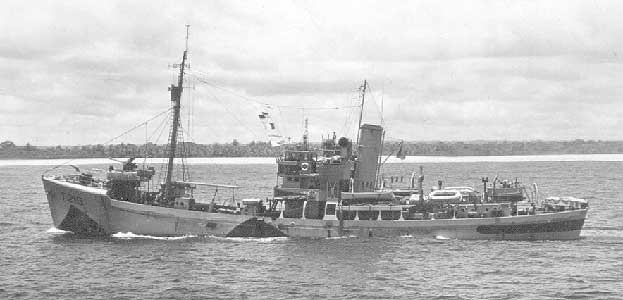 |
(above) 'Hills Class' Admiralty AS/MS trawler HMS Butser photographed while on patrol North Africa 1943 |
 |
 |